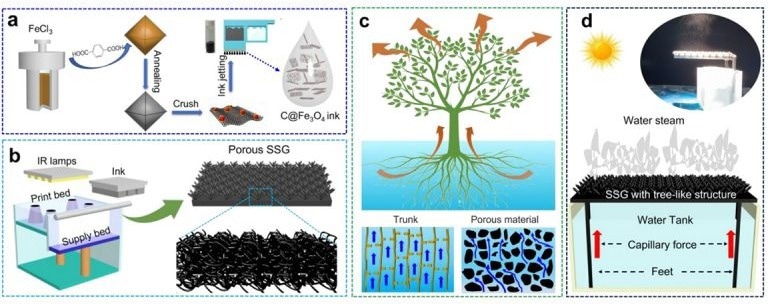In a recent study published in the journal Applied Physics Reviews, researchers from the Nanyang Technological University introduced a novel technique for printing functional nanocomposites for multi-jet fusion (MJF) and a state-of-the-art approach for creating effective SSGs for desalination.
 The fabrication and application of MJF-printed SSGs. (a) Synthesis process of the C@Fe3O4 ink for MJF printing. (b) Illustration of the MJF testbed setup and the structure of printed SSGs. (c) Schematic illustration of transpiration in plants and water transport in trunk and porous materials. (d) The illustrated evaporation process of water on the surface of MJF-printed SSG under solar irradiation. Image Credit: Yanbei Hou et al.
The fabrication and application of MJF-printed SSGs. (a) Synthesis process of the C@Fe3O4 ink for MJF printing. (b) Illustration of the MJF testbed setup and the structure of printed SSGs. (c) Schematic illustration of transpiration in plants and water transport in trunk and porous materials. (d) The illustrated evaporation process of water on the surface of MJF-printed SSG under solar irradiation. Image Credit: Yanbei Hou et al.
The team turned to Solar Steam Generators (SSGs), which are becoming a viable method for desalinating seawater, in response to the world's approaching freshwater shortage. Desalination is one expensive and energy-intensive way to address water scarcity.
This sustainable energy method replicates the natural water cycle using solar energy to evaporate and separate water. Nevertheless, the technique is constrained by the requirement to create intricate topologies to enhance the surface area required to get elevated water evaporation efficiency.
The group used 3D printing to its full potential to get beyond this obstacle and looked to trees for design inspiration.
We created SSGs with exceptional photothermal performance and self-cleaning properties, using a treelike porous structure significantly enhances water evaporation rates and ensures continuous operation by preventing salt accumulation its performance remains relatively stable even after prolonged testing.
Kun Zhou, Professor, Department of Mechanical Engineering, Nanyang Technological University
Their method is based on the principle of light-to-thermal energy conversion, in which solar radiation is absorbed by the SSGs, which then transforms it into heat and evaporates the water or ocean. By removing accumulated salt, the porous structure of the SSG contributes to improved self-cleaning and sustained desalination performance.
By using an effective photothermal fusing agent, MJF printing technology can rapidly create parts with intricate designs, to improve the photothermal conversion efficiency of fusing agents and printed parts, we developed a novel type of fusing agent derived from metal-organic frameworks.
Kun Zhou, Professor, Department of Mechanical Engineering, Nanyang Technological University
Their SSGs, which are made of tiny microstructures shaped like trees and effectively distribute heat, were inspired by plant transpiration.
Our bioinspired design increases the surface area of the SSG. Using a treelike design increases the surface area of the SSG, which enhances the water transport and boosts evaporation efficiency.
Kun Zhou, Professor, Department of Mechanical Engineering, Nanyang Technological University
One major surprise was the significant water evaporation rate seen in field testing and simulated conditions. Even after a protracted test, the desalinated water continuously fulfilled drinking water regulations.
Zhou said, “This demonstrates the practicality and efficiency of our approach. And it can be quickly and easily mass-produced via MJF commercial printers.”
The group's efforts have a great deal of promise to alleviate the freshwater shortage.
Zhou said, “Our SSGs can be used in regions with limited access to freshwater to provide a sustainable and efficient desalination solution. Beyond desalination, it can be adapted for other applications that require efficient solar energy conversion and water purification.”
Journal Reference:
Hou, Y., et al. (2024) 3D printing of bio-inspired porous polymeric solar steam generators for efficient and sustainable desalination. Applied Physics Reviews. doi.org/10.1063/5.0200505.